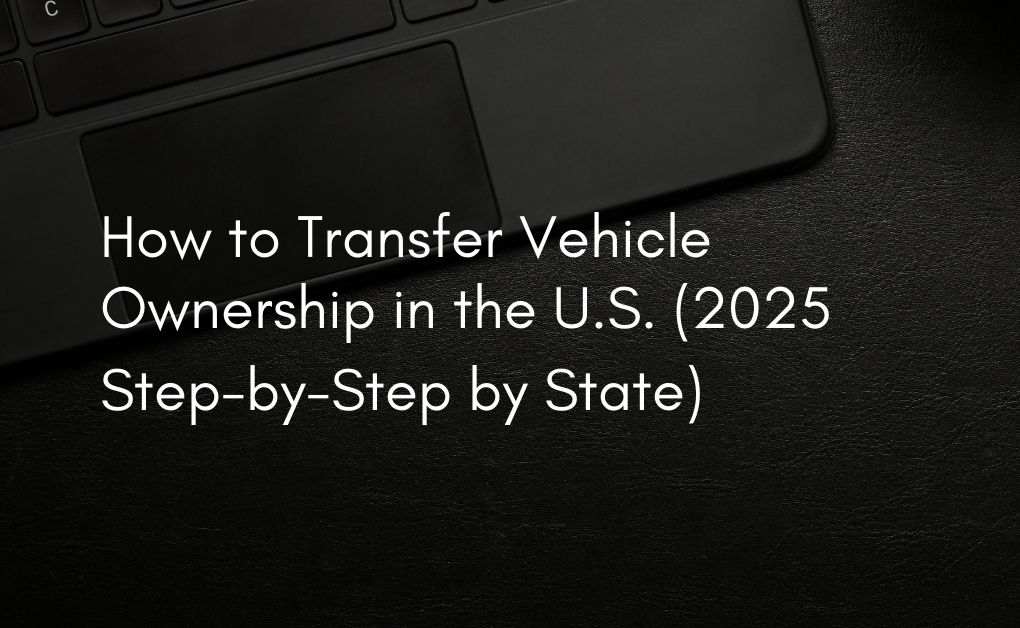Transferring ownership of a vehicle in the U.S. isn’t as simple as handing over the keys—it’s a legal process that varies by state and involves paperwork, fees, and sometimes even inspections. Whether you're buying, selling, gifting, or inheriting a car, it's crucial to follow your state’s guidelines to avoid penalties and ensure the title is properly transferred.
This 2025 guide walks you through the general process and highlights state-specific differences to help you complete a smooth, legal transfer of vehicle ownership.
Why Vehicle Title Transfers Matter
When you sell or buy a car, the title document (or pink slip) proves legal ownership. Failing to transfer the title means the state still considers the previous owner responsible for:
- Parking tickets
- Registration fees
- Tolls or violations
- Accidents involving the vehicle
Properly transferring ownership protects both the buyer and seller.
General Step-by-Step Process to Transfer a Vehicle Title (All States)
While each state may have its own quirks, here’s the typical process in most U.S. states:
1. Complete the Title Certificate
The seller must:
- Fill in the odometer reading (for cars under 10 years old)
- Sign the title as the current owner
- List the sale price
- Include the buyer's full name and address
The buyer must:
- Sign the title acknowledging receipt
- Confirm odometer disclosure, if required
2. Bill of Sale (Some States Only)
Some states like Louisiana, Nebraska, and West Virginia require a bill of sale in addition to the signed title. This document includes:
- Buyer and seller names
- Date of sale
- Vehicle make, model, year, and VIN
- Purchase price
Many states offer downloadable templates on their DMV websites.
3. Emissions or Safety Inspection (State-Dependent)
Before transfer, states like California, New York, and Missouri may require a smog check or safety inspection.
4. Pay Fees and Taxes
Expect to pay:
- Title transfer fees (usually $15–$150 depending on the state)
- Sales tax (based on vehicle value and location)
- Registration renewal (if applicable)
Fees are paid by the buyer at the DMV or relevant state agency.
5. Submit the Paperwork
Buyers must visit the state DMV (or equivalent agency) and submit:
- Signed title
- Bill of sale (if required)
- Valid ID
- Insurance proof
- Payment for fees
Some states allow online or mail submissions, but in-person visits may still be required.
6. Remove License Plates (Sometimes)
In states like Texas and California, plates stay with the seller. In others like Florida and Pennsylvania, they stay with the car.
State-by-State Vehicle Title Transfer Highlights (2025)
Let’s look at some notable state-specific requirements for 2025:
California (CA)
- Use the DMV's online Notice of Transfer and Release of Liability within 5 days.
- Smog check required if the vehicle is over 4 years old.
- Fees: $15 title fee + use tax.
👉 CA DMV Vehicle Transfer Page
Texas (TX)
- Title Application (Form 130-U) required.
- Must file vehicle transfer notification within 30 days.
- Sales tax of 6.25% applies.
Florida (FL)
- Both parties must be present to notarize the title.
- Title fee: $75.75 (electronic), $77.75 (paper).
- License plates stay with the seller.
New York (NY)
- Odometer and bill of sale both required.
- Sales tax must be paid at the DMV.
- New registration and plates required for buyers.
👉 NY DMV Transfer Instructions
Illinois (IL)
- Title must be submitted within 20 days of purchase.
- Odometer disclosure form required (Form VSD 333).
- Pay title transfer fee ($155) and sales tax.
Special Situations
Gifting a Car
- Some states (like California and Texas) allow gift exemptions from sales tax if the transfer is between family members.
- You'll typically need a notarized affidavit of gift.
Transferring a Vehicle After Death
- Probate may be required depending on the estate.
- Some states offer a Transfer on Death (TOD) title, avoiding court.
- Bring a death certificate and legal documentation to the DMV.
Buying from a Dealership
- Dealers typically handle the title paperwork.
- Ensure you receive a temporary permit if your plates aren't ready.
Tips to Avoid Mistakes
- Always double-check VIN numbers.
- Don’t leave the “buyer” section blank—it could lead to title jumping (illegal in many states).
- Take photos of the completed title and bill of sale for your records.
- Remove personal information from the car (e.g., GPS data, toll tags).
- Don’t cancel insurance until after the sale is finalized.
FAQ
Q: Can I transfer a title online in 2025?
A: Some states (like California and Arizona) offer online services, but most still require some in-person steps due to ID and documentation checks.
Q: What happens if I lose my title before selling?
A: Request a duplicate title from your state DMV. You’ll need ID and a small fee.
Q: Is a notary required to transfer a title?
A: Not all states require notarization, but states like Louisiana and North Carolina do. Always check your local rules.
Q: How long do I have to transfer the title after buying a car?
A: Usually between 10 to 30 days, depending on the state. Late transfers can result in penalties.
Q: Can I sell a car without transferring the title?
A: No. You must legally transfer the title to the new owner. Selling without title transfer may be considered fraud.

